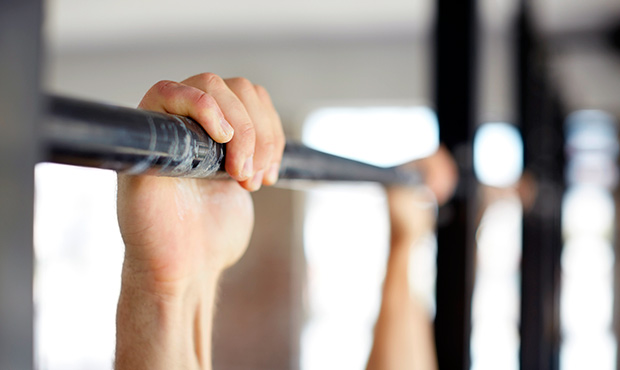
When it comes to upper-body workouts, pull-ups take the cake.
Not only are they one of the most convenient exercises that don't require lot's of equipment or cable attachments—literally a bar is all you need—they're also a fundamental compound movement that builds your back and biceps.
All that talk you hear about the importance of doing squats to target your quads, glutes and hamstrings? Think of pull-ups as the equivalent for your upper body. Pull-ups are also a great way to increase grip strength and balance out your physique, so that your push movements, like the bench and overhead press, don’t leave your back short-changed.
Pull-ups can be tough to master, though. Starting with pull-up variations can help you learn how to do a pull-up effectively.
What Do Pull-Ups Work?
Before you approach the bar, you should know what muscles you’re targeting, where you should feel the burn and what you’re going to engage.
Unlike isolation movements, the compound exercise of a pull-up works a large number of muscles in your upper body. The classic pull-up is done with a pronated grip—with your palms facing away from you—and with your hands placed about shoulder-width apart. When done correctly, a pull-up engages your upper back, shoulders, lats and biceps.
Modify Your Way to the Perfect Pull-Up
If you grab the bar, pull and still find yourself dangling just a few inches from the gym floor, don’t fret. You might not have your first strict pull-up yet, but by adding these modifications to your routine, you’ll work your way to back-building greatness in no time.
Starting with modifications will help you get used to the movement and feel which muscles are being engaged. They will also help you focus on form so that when you do perform your first rep, you can do so with a full range of motion.
Pull-Up Variations
If you haven't mastered pull-ups yet, start with these pull-up variations.
1. Jumping Pull-Ups
Jumping pull-ups are a great way to start learning proper form. Why? You’re stronger when lowering weight than you are when lifting it. This means that while you might be struggling on the concentric—or contracting—portion of the movement, you’ve likely got more control of the eccentric—or lowering—phase. Jumping up and lowering yourself will help you get the motion down.
The controlled descent of jumping pull-ups can also help you build strength faster.
How to do a jumping pull-up:
- Stand under a bar and jump to the top position of a pull-up. Your chin should be over the bar. If needed, use a platform or box.
- Hold at the top position for a count of two and focus on squeezing your shoulder blades together.
- Lower slowly, letting your feet touch the ground.
- Staying light and fast on the balls of your feet, jump up again. Repeat for reps.
2. Negative Pull-Ups
Kick things up a notch by adding some time to the lowering portion of the jumping pull-up. Since you’re working with gravity, this portion of the movement is less taxing and helps build the muscles needed to work your way up to your first pull-up.
Complete your negative in a slow-and-controlled manner. On every rep, create tension by fully engaging your upper body.
How to do a negative pull-up:
- Jump up or use a box to pull yourself up on the pull-up bar.
- Slowly lower yourself down. Keep your core tight and engage your back as you descend.
- Lower to full extension in a controlled manner without just letting yourself fall.
- Repeat for reps, trying to build on the time eccentric phase. Try to work your way up to a 30-second, progressive release.
3. Partner-Assisted Pull-Ups
If you’re working out with a buddy, partner-assisted pull-ups are the way to go. A spotter can help you pull yourself up, giving you enough leverage and resistance to push against while still ensuring you gain strength by doing the majority of the work.
How to do a partner-assisted pull-up:
- Standing on a box or jumping up, grab the bar with a wide, overhand grip. Bend your knees. Have your friend cradle your feet.
- Pushing off of your partner’s hands, pull your body up until your chin is just above the bar.
- Lower your body until your arms and shoulders are fully extended.
- Repeat for reps, increasing or decreasing the added support as needed.
Working out solo? While it’s not as good of a modification—largely because bands provide uneven assistance and extra help at the bottom of the movement (where most people need to build strength most)—band-assisted pull-ups allow beginners to mimic the movement and, eventually, complete more reps.
Just make sure that you’re slowly weaning yourself off the band and reaching for one with less give. Aim to use a smaller band each week so that you’re pulling more of the load.
4. Scapular Pull-Ups
Scap pull-ups will help you learn how to initiate a pull-up. Engaging your lats by squeezing your shoulder blades down and back is the foundation for every pull-up. Working on this essential starting movement will teach you how to stay tight at the start of your pull, setting you up for success.
How to do a scapular pull-up:
- Jump up and grab onto the bar. Hold yourself in a hollow hang position.
- Draw your shoulder blades down and back. Imagine using them to squeeze an apple placed on your spine.
- Return to the starting position. Repeat.
You won't move much during this pull-up variation, but it is a great exercise for scapular engagement and learning how to initiate the pull.
5. Isometrics
There’s something to be said for holding a weight without movement. Isometric training, or exercises where the joint doesn’t contract or release at all, builds strength, too. Since the 1970s, studies have shown that isometric training recruits more muscle units, improves load efficiency and enhances oxidative capacity—or energy sources—in skeletal muscle.
If you’re new to pull-ups, holding your body up for a few seconds at the part of the movement that’s weakest for you can help build strength in areas that need it most.
How to do isometrics:
- Grip the bar with a pronated grip. Pull yourself up until your chest is level with the bar (using a box, partner or platform).
- Keeping your chest out and elbows pulled back, squeeze your shoulder blades together.
- Hold still for as long as possible. Release and repeat.
Pull-Up to the Max
Once you’ve mastered your first strict pull-up and seen the other side of the bar, it’s easy to increase the level of difficulty.
Boosting the intensity of your workout only takes a weight plate and a chain or a simple, strategically placed dumbbell between your feet. Just remember not to add weight to your pull-up until you’ve built up your bodyweight reps.
Pull-Up FAQs
Why are pull-ups so difficult?
Pull-ups require you to lift your entire body using only your upper body. The arms and shoulders are generally not as strong as the legs. Since pull-ups eliminate any assistance from the legs, they can be difficult to master. They also require correct form and technique. Engaging the right muscles is necessary for success.
How do you build up the strength to do a pull-up?
Lat pull-downs, bent-over rows, and bench presses can all help you build the strength needed to perform a strict pull-up. Any movement that targets the shoulders, back, and arms, primarily the lats and biceps, is great for building pull-up strength.
How long does it take to learn how to do a pull-up?
It typically takes someone four to 12 weeks to train to do an unassisted pull-up. However, it depends heavily on starting fitness level and strength, as well as how often you train the movement.
Connect with us on Twitter, Facebook, Instagram or Pinterest for more tips, recipes and ideas to fuel your ACTIVE life.
 Stay in shape in a fitness class or read more fitness articles.
Stay in shape in a fitness class or read more fitness articles.


